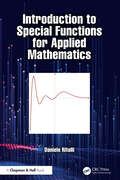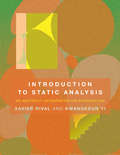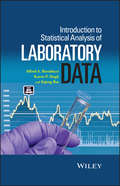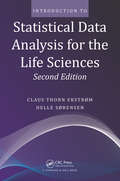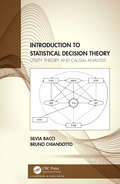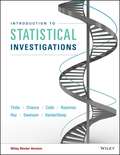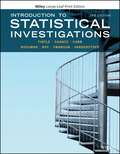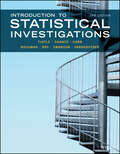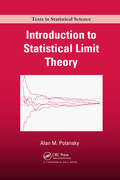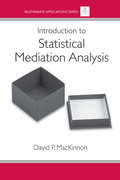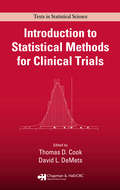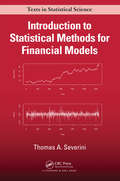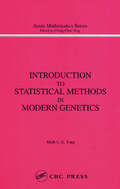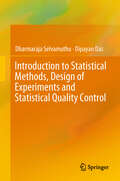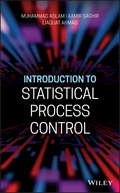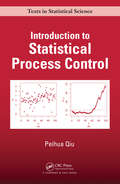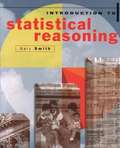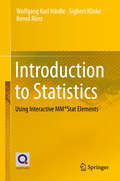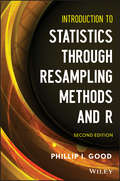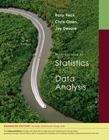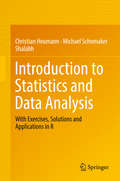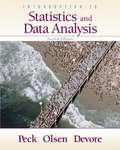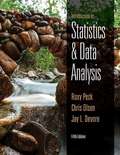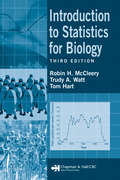- Table View
- List View
Introduction to Special Functions for Applied Mathematics
by Daniele RitelliIntroduction to Special Functions for Applied Mathematics introduces readers to the topic of special functions, with a particular focus on applications. Designed to build swiftly from the more basic special functions towards more advanced material, the book is ideally suited for an intensive one semester course. Complemented with various solved examples and exercises to support students and instructors, the book can be used for both self-study and directed learning.Features Suitable for graduate level students or beginning PhD students in mathematics, physics, statistics, and economics No previous background in complex analysis required Numerous solved examples and exercises.
Introduction to Static Analysis: An Abstract Interpretation Perspective
by Xavier Rival Kwangkeun YiA self-contained introduction to abstract interpretation–based static analysis, an essential resource for students, developers, and users.Static program analysis, or static analysis, aims to discover semantic properties of programs without running them. It plays an important role in all phases of development, including verification of specifications and programs, the synthesis of optimized code, and the refactoring and maintenance of software applications. This book offers a self-contained introduction to static analysis, covering the basics of both theoretical foundations and practical considerations in the use of static analysis tools. By offering a quick and comprehensive introduction for nonspecialists, the book fills a notable gap in the literature, which until now has consisted largely of scientific articles on advanced topics.The text covers the mathematical foundations of static analysis, including semantics, semantic abstraction, and computation of program invariants; more advanced notions and techniques, including techniques for enhancing the cost-accuracy balance of analysis and abstractions for advanced programming features and answering a wide range of semantic questions; and techniques for implementing and using static analysis tools. It begins with background information and an intuitive and informal introduction to the main static analysis principles and techniques. It then formalizes the scientific foundations of program analysis techniques, considers practical aspects of implementation, and presents more advanced applications. The book can be used as a textbook in advanced undergraduate and graduate courses in static analysis and program verification, and as a reference for users, developers, and experts.
Introduction to Statistical Analysis of Laboratory Data
by Sejong Bae Alfred Bartolucci Karan P. SinghIntroduction to Statistical Analysis of Laboratory Data presents a detailed discussion of important statistical concepts and methods of data presentation and analysis Provides detailed discussions on statistical applications including a comprehensive package of statistical tools that are specific to the laboratory experiment process Introduces terminology used in many applications such as the interpretation of assay design and validation as well as "fit for purpose" procedures including real world examples Includes a rigorous review of statistical quality control procedures in laboratory methodologies and influences on capabilities Presents methodologies used in the areas such as method comparison procedures, limit and bias detection, outlier analysis and detecting sources of variation Analysis of robustness and ruggedness including multivariate influences on response are introduced to account for controllable/uncontrollable laboratory conditions
Introduction to Statistical Data Analysis for the Life Sciences
by Claus Thorn Ekstrom Helle SørensenA Hands-On Approach to Teaching Introductory StatisticsExpanded with over 100 more pages, Introduction to Statistical Data Analysis for the Life Sciences, Second Edition presents the right balance of data examples, statistical theory, and computing to teach introductory statistics to students in the life sciences. This popular textbook covers the m
Introduction to Statistical Decision Theory: Utility Theory and Causal Analysis
by Silvia Bacci Bruno ChiandottoIntroduction to Statistical Decision Theory: Utility Theory and Causal Analysis provides the theoretical background to approach decision theory from a statistical perspective. It covers both traditional approaches, in terms of value theory and expected utility theory, and recent developments, in terms of causal inference. The book is specifically designed to appeal to students and researchers that intend to acquire a knowledge of statistical science based on decision theory.Features Covers approaches for making decisions under certainty, risk, and uncertainty Illustrates expected utility theory and its extensions Describes approaches to elicit the utility function Reviews classical and Bayesian approaches to statistical inference based on decision theory Discusses the role of causal analysis in statistical decision theory
Introduction to Statistical Investigations
by George W. Cobb Allan J. Rossman Beth L. Chance Soma Roy Nathan L. Tintle Todd M. Swanson Jill L. VanderStoepThis book leads students to learn about the process of conducting statistical investigations from data collection, to exploring data, to statistical inference, to drawing appropriate conclusions. The authors focus on genuine research studies, active learning, and effective use of technology. In particular, they use simulation and randomization tests to introduce students to statistical inference, yielding a strong conceptual foundation that bridges students to theory-based inference approaches, which are presented throughout the book. This approach allows students to see the logic and scope of inference in the first chapter and to cycle through these ideas. The implementation follows the GAISE recommendations endorsed by the American Statistical Association.
Introduction to Statistical Investigations
by George W. Cobb Allan J. Rossman Beth L. Chance Soma Roy Nathan L. Tintle Todd M. Swanson Jill L. VanderStoepThis book provides a unified framework for explaining variation across study designs and variable types, helping students increase their statistical literacy and appreciate the indispensable role of statistics in scientific research. Requiring only basic algebra as a prerequisite, the program uses the immersive, simulation-based inference approach for which the author team is known. Students engage with various aspects of data collection and analysis using real data and clear explanations designed to strengthen multivariable understanding and reinforce concepts. <p><p> Each chapter follows a coherent six-step statistical exploration and investigation method (ask a research question, design a study, explore the data, draw inferences, formulate conclusions, and look back and ahead) enabling students to assess a variety of concepts in a single assignment. Challenging questions based on research articles strengthen critical reading skills, fully worked examples demonstrate essential concepts and methods, and engaging visualizations illustrate key themes of explained variation. The end-of-chapter investigations expose students to various applications of statistics in the real world using real data from popular culture and published research studies in variety of disciplines. Accompanying examples throughout the text, user-friendly applets enable students to conduct the simulations and analyses covered in the book.
Introduction to Statistical Investigations
by George W. Cobb Allan J. Rossman Beth L. Chance Soma Roy Nathan L. Tintle Todd M. Swanson Jill L. VanderstoepIntroduction to Statistical Investigations, Second Edition provides a unified framework for explaining variation across study designs and variable types, helping students increase their statistical literacy and appreciate the indispensable role of statistics in scientific research. Requiring only basic algebra as a prerequisite, the program uses the immersive, simulation-based inference approach for which the author team is known. Students engage with various aspects of data collection and analysis using real data and clear explanations designed to strengthen multivariable understanding and reinforce concepts. <P><P>Each chapter follows a coherent six-step statistical exploration and investigation method (ask a research question, design a study, explore the data, draw inferences, formulate conclusions, and look back and ahead) enabling students to assess a variety of concepts in a single assignment. Challenging questions based on research articles strengthen critical reading skills, fully worked examples demonstrate essential concepts and methods, and engaging visualizations illustrate key themes of explained variation. The end-of-chapter investigations expose students to various applications of statistics in the real world using real data from popular culture and published research studies in variety of disciplines. Accompanying examples throughout the text, user-friendly applets enable students to conduct the simulations and analyses covered in the book.
Introduction to Statistical Limit Theory
by Alan M. PolanskyHelping students develop a good understanding of asymptotic theory, Introduction to Statistical Limit Theory provides a thorough yet accessible treatment of common modes of convergence and their related tools used in statistics. It also discusses how the results can be applied to several common areas in the field.The author explains as much of the
Introduction to Statistical Mediation Analysis (Multivariate Applications Ser.)
by David MacKinnonThis volume introduces the statistical, methodological, and conceptual aspects of mediation analysis. Applications from health, social, and developmental psychology, sociology, communication, exercise science, and epidemiology are emphasized throughout. Single-mediator, multilevel, and longitudinal models are reviewed. The author's goal is to help the reader apply mediation analysis to their own data and understand its limitations. Each chapter features an overview, numerous worked examples, a summary, and exercises (with answers to the odd numbered questions). The accompanying CD contains outputs described in the book from SAS, SPSS, LISREL, EQS, MPLUS, and CALIS, and a program to simulate the model. The notation used is consistent with existing literature on mediation in psychology. The book opens with a review of the types of research questions the mediation model addresses. Part II describes the estimation of mediation effects including assumptions, statistical tests, and the construction of confidence limits. Advanced models including mediation in path analysis, longitudinal models, multilevel data, categorical variables, and mediation in the context of moderation are then described. The book closes with a discussion of the limits of mediation analysis, additional approaches to identifying mediating variables, and future directions. Introduction to Statistical Mediation Analysis is intended for researchers and advanced students in health, social, clinical, and developmental psychology as well as communication, public health, nursing, epidemiology, and sociology. Some exposure to a graduate level research methods or statistics course is assumed. The overview of mediation analysis and the guidelines for conducting a mediation analysis will be appreciated by all readers.
Introduction to Statistical Methods for Clinical Trials (Chapman & Hall/CRC Texts in Statistical Science)
by Thomas D. Cook David L. DeMetsThis text provides a solid understanding of the various statistical topics relevant to the design, monitoring, and analysis of a clinical trial. It covers basic experimental design, sample size, randomization procedures, interim and survival analyses, quality of life assessment, and longitudinal methods. The book describes all phases of a clinical trial and explores the advantages of and objections to the intent-to-treat principle as well as its implementation. With exercises at the end of most chapters, it also illustrates methods using examples with real data from a variety of disease areas, including heart and lung diseases, cancer, and AIDS.
Introduction to Statistical Methods for Financial Models (Chapman & Hall/CRC Texts in Statistical Science)
by Thomas A SeveriniThis book provides an introduction to the use of statistical concepts and methods to model and analyze financial data. The ten chapters of the book fall naturally into three sections. Chapters 1 to 3 cover some basic concepts of finance, focusing on the properties of returns on an asset. Chapters 4 through 6 cover aspects of portfolio theory and the methods of estimation needed to implement that theory. The remainder of the book, Chapters 7 through 10, discusses several models for financial data, along with the implications of those models for portfolio theory and for understanding the properties of return data. The audience for the book is students majoring in Statistics and Economics as well as in quantitative fields such as Mathematics and Engineering. Readers are assumed to have some background in statistical methods along with courses in multivariate calculus and linear algebra.
Introduction to Statistical Methods in Modern Genetics (Modern Analysis Series)
by M.C. YangThough the basic statistical theory behind modern genetics is not that difficult, most statistical genetics papers are not easy to read for beginners, and fitting formulae to a particular area of application quickly becomes very tedious. Introduction to Statistical Methods in Modern Genetics makes a clear distinction between the necessary and unnecessary complexities. The author keeps the derivations of methods simple without losing the mathematical details. He also provides the necessary background in modern genetics for newcomers to the field, including discussion ranging from biological and molecular experiments to gene hunting and genetic engineering.
Introduction to Statistical Methods, Design of Experiments and Statistical Quality Control
by Dharmaraja Selvamuthu Dipayan DasThis book provides an accessible presentation of concepts from probability theory, statistical methods, the design of experiments and statistical quality control. It is shaped by the experience of the two teachers teaching statistical methods and concepts to engineering students, over a decade. Practical examples and end-of-chapter exercises are the highlights of the text as they are purposely selected from different fields. Statistical principles discussed in the book have great relevance in several disciplines like economics, commerce, engineering, medicine, health-care, agriculture, biochemistry, and textiles to mention a few. A large number of students with varied disciplinary backgrounds need a course in basics of statistics, the design of experiments and statistical quality control at an introductory level to pursue their discipline of interest. No previous knowledge of probability or statistics is assumed, but an understanding of calculus is a prerequisite. The whole book serves as a master level introductory course in all the three topics, as required in textile engineering or industrial engineering. Organised into 10 chapters, the book discusses three different courses namely statistics, the design of experiments and quality control. Chapter 1 is the introductory chapter which describes the importance of statistical methods, the design of experiments and statistical quality control. Chapters 2–6 deal with statistical methods including basic concepts of probability theory, descriptive statistics, statistical inference, statistical test of hypothesis and analysis of correlation and regression. Chapters 7–9 deal with the design of experiments including factorial designs and response surface methodology, and Chap. 10 deals with statistical quality control.
Introduction to Statistical Process Control
by Muhammad Aslam Aamir Saghir Liaquat AhmadAn Introduction to the Fundamentals and History of Control Charts, Applications, and Guidelines for Implementation Introduction to Statistical Process Control examines various types of control charts that are typically used by engineering students and practitioners. This book helps readers develop a better understanding of the history, implementation, and use-cases. Students are presented with varying control chart techniques, information, and roadmaps to ensure their control charts are operating efficiently and producing specification-confirming products. This is the essential text on the theories and applications behind statistical methods and control procedures. This eight-chapter reference breaks information down into digestible sections and covers topics including: ● An introduction to the basics as well as a background of control charts ● Widely used and newly researched attributes of control charts, including guidelines for implementation ● The process capability index for both normal and non-normal distribution via the sampling of multiple dependent states ● An overview of attribute control charts based on memory statistics ● The development of control charts using EQMA statistics For a solid understanding of control methodologies and the basics of quality assurance, Introduction to Statistical Process Control is a definitive reference designed to be read by practitioners and students alike. It is an essential textbook for those who want to explore quality control and systems design.
Introduction to Statistical Process Control (Chapman & Hall/CRC Texts in Statistical Science)
by Peihua QiuA major tool for quality control and management, statistical process control (SPC) monitors sequential processes, such as production lines and Internet traffic, to ensure that they work stably and satisfactorily. Along with covering traditional methods, Introduction to Statistical Process Control describes many recent SPC methods that improve upon
Introduction to Statistical Reasoning
by Gary N. SmithThis textbook is intended for an introductory statistics course that will help students to develop their statistical reasoning. This book provides hundreds of interesting and relevant examples, and discusses not only the uses but also the abuses of statistics. These examples show how statistical reasoning can be used correctly to answer important questions and it also exposes the errors--accidental or intentional--that people often make with statistics. The book has special features of: Have You Ever Wondered?, How To Do It Boxes, Student Projects, Real Data, and Technology.
Introduction to Statistics
by Wolfgang Karl Härdle Sigbert Klinke Bernd RönzMM*Stat, together with its enhanced online version with interactive examples, offers a flexible tool that facilitates the teaching of basic statistics. It covers all the topics found in introductory descriptive statistics courses, including simple linear regression and time series analysis, the fundamentals of inferential statistics (probability theory, random sampling and estimation theory), and inferential statistics itself (confidence intervals, testing). MM*Stat is also designed to help students rework class material independently and to promote comprehension with the help of additional examples. Each chapter starts with the necessary theoretical background, which is followed by a variety of examples. The core examples are based on the content of the respective chapter, while the advanced examples, designed to deepen students' knowledge, also draw on information and material from previous chapters. The enhanced online version helps students grasp the complexity and the practical relevance of statistical analysis through interactive examples and is suitable for undergraduate and graduate students taking their first statistics courses, as well as for undergraduate students in non-mathematical fields, e. g. economics, the social sciences etc. All R codes and data sets may be downloaded via the quantlet download center
Introduction to Statistics Through Resampling Methods and R
by Phillip I. GoodA highly accessible alternative approach to basic statistics Praise for the First Edition: "Certainly one of the most impressive little paperback 200-page introductory statistics books that I will ever see . . . it would make a good nightstand book for every statistician."--Technometrics Written in a highly accessible style, Introduction to Statistics through Resampling Methods and R, Second Edition guides students in the understanding of descriptive statistics, estimation, hypothesis testing, and model building. The book emphasizes the discovery method, enabling readers to ascertain solutions on their own rather than simply copy answers or apply a formula by rote. The Second Edition utilizes the R programming language to simplify tedious computations, illustrate new concepts, and assist readers in completing exercises. The text facilitates quick learning through the use of: More than 250 exercises--with selected "hints"--scattered throughout to stimulate readers' thinking and to actively engage them in applying their newfound skills An increased focus on why a method is introduced Multiple explanations of basic concepts Real-life applications in a variety of disciplines Dozens of thought-provoking, problem-solving questions in the final chapter to assist readers in applying statistics to real-life applications Introduction to Statistics through Resampling Methods and R, Second Edition is an excellent resource for students and practitioners in the fields of agriculture, astrophysics, bacteriology, biology, botany, business, climatology, clinical trials, economics, education, epidemiology, genetics, geology, growth processes, hospital administration, law, manufacturing, marketing, medicine, mycology, physics, political science, psychology, social welfare, sports, and toxicology who want to master and learn to apply statistical methods.
Introduction to Statistics and Data Analysis
by Roxy Peck Chris Olsen Jay DevoreThis book introduces you to the study of statistics and data analysis by using real data and attention-grabbing examples. The authors guide you through an intuition-based learning process that stresses interpretation and communication of statistical information. They help you grasp concepts and cement your comprehension by using simple notation-frequently substituting words for symbols. You will also find coverage of the graphing calculator as a problem-solving tool, plus hands-on activities in each chapter that allow you to practice statistics firsthand.
Introduction to Statistics and Data Analysis
by Christian Heumann Michael Schomaker ShalabhThis introductory statistics textbook conveys the essential concepts and tools needed to develop and nurture statistical thinking. It presents descriptive, inductive and explorative statistical methods and guides the reader through the process of quantitative data analysis. In the experimental sciences and interdisciplinary research, data analysis has become an integral part of any scientific study. Issues such as judging the credibility of data, analyzing the data, evaluating the reliability of the obtained results and finally drawing the correct and appropriate conclusions from the results are vital. The text is primarily intended for undergraduate students in disciplines like business administration, the social sciences, medicine, politics, macroeconomics, etc. It features a wealth of examples, exercises and solutions with computer code in the statistical programming language R as well as supplementary material that will enable the reader to quickly adapt all methods to their own applications.
Introduction to Statistics and Data Analysis (2nd Edition)
by Roxy Peck Chris Olsen Jay DevoreThis high school textbook is designed to conform to the syllabus of the Advanced Placement Statistics course. Featuring simplified notation as well as coverage of advanced topics such as multiple regression, the text can be used in quarter or year-long courses. The text begins with an overview of the data analysis process from planning through interpretation of results, and then presents material according to the sequence of the data analysis process, with sections on collecting data and descriptive methods, probability, basic one- and two-sample inferential techniques, and more advanced inferential methodology. Most chapters include a section on interpreting and communicating results. Most exercises and activities involve real data from journal articles and other published sources, highlighting applications in many disciplines, such as college life, leisure and popular culture, medical science, social issues, and sports. A companion website offers graphic calculator instructions, plus data sets and applets for activities. This fourth edition contains 50 new examples and 270 new exercises. About 90 exercises now have video solutions online for download. Peck is affiliated with California Polytechnic State University. Annotation ©2012 Book News, Inc. , Portland, OR (booknews. com)
Introduction to Statistics and Data Analysis (Fifth Edition)
by Roxy Peck Chris Olsen Jay L. DevoreRoxy Peck, Chris Olsen, and Jay Devore's new edition uses real data and attention-grabbing examples to introduce students to the study of statistics and data analysis. Traditional in structure yet modern in approach, this text guides students through an intuition-based learning process that stresses interpretation and communication of statistical information. Simple notation--including frequent substitution of words for symbols--helps students grasp concepts and cement their comprehension. Hands-on activities and interactive applets allow students to practice statistics firsthand. INTRODUCTION TO STATISTICS AND DATA ANALYSIS includes updated coverage of most major technologies, as well as expanded coverage of probability.
Introduction to Statistics and Data Analysis, AP® Edition
by Roxy Peck Chris Olsen Jay L. DevoreNIMAC-sourced textbook
Introduction to Statistics for Biology
by Tom Hart Trudy A. Watt Robin H. McCleeryEven though an understanding of experimental design and statistics is central to modern biology, undergraduate and graduate students studying biological subjects often lack confidence in their numerical abilities. Allaying the anxieties of students, Introduction to Statistics for Biology, Third Edition provides a painless introduction to the subject while demonstrating the importance of statistics in contemporary biological studies.New to the Third EditionMore detailed explanation of the ideas of elementary probability to simplify the rationale behind hypothesis testing, before moving on to simple tests An emphasis on experimental design and data simulation prior to performing an experiment A general template for carrying out statistical tests from hypothesis to interpretation Worked examples and updated Minitab analyses and graphics Downloadable resources contains a free trial version of MinitabUsing Minitab throughout to present practical examples, the authors emphasize the interpretation of computer output. With its nontechnical approach and practical advice, this student-friendly introductory text lays the foundation for the advanced study of statistical analysis.
